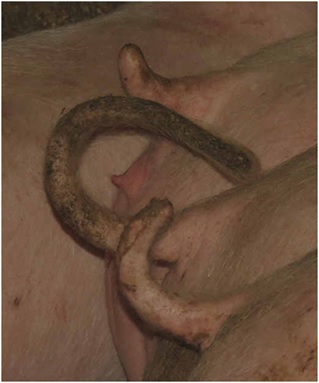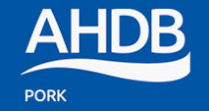Mix of tail lengths

What To Look For:
Tail biting is more likely in pens where pigs have a mix of tail lengths – either a mix of docked and undocked tails, or a mix of docked tail lengths (eg some at 1/3 docked length, some at 2/3 docked length). Also look for batches/pens where there may be an occasional undocked pig among otherwise docked animals.
A mix of tail lengths is likely to stimulate the interest of pigs because of the novelty of the different lengths and movements of the tail. As well as this, mixed tail lengths can highlight a number of possible management issues:
- Where management procedures at weekends, such as docking, are different to weekday routine and care
- Runty piglets (often left undocked to minimise stress) may be more likely to become tail biters
- Different docking opinions and techniques by stockpeople
- Inconsistent use of docking equipment, or difficulties using docking equipment
- Mixing of previously separate groups (e.g. from different source farms or buildings)
- Mixing of pigs intended to be breeding gilts back into mainstream finishing
Additional information:
Tail biting is more likely in pens where pigs have a mix of tail lengths – either a mix of docked and undocked tails, or a mix of docked tail lengths (eg some at 1/3 docked length, some at 2/3 docked length). Also look for batches/pens where there may be an occasional undocked pig among otherwise docked animals.
A mix of tail lengths is likely to stimulate the interest of pigs because of the novelty of the different lengths and movements of the tail. As well as this, mixed tail lengths can highlight a number of possible management issues:
- Where management procedures at weekends, such as docking, are different to weekday routine and care
- Runty piglets (often left undocked to minimise stress) may be more likely to become tail biters
- Different docking opinions and techniques by stockpeople
- Inconsistent use of docking equipment, or difficulties using docking equipment
- Mixing of previously separate groups (e.g. from different source farms or buildings)
- Mixing of pigs intended to be breeding gilts back into mainstream finishing
Suggestions:
Where tail docking is still acknowledged as necessary by your vet:
- If there is a problem with a mix of tail lengths, ask your supplier to provide pigs with an agreed and standardised tail length
- Improve training for stockpeople who carry out docking, so that tails can be docked to a certain agreed length. (If stockpeople are not confident using this equipment, provide suitable training)
- Ensure there are enough staff at weekends to safely carry out all routine management requirements to agreed standards, and ensure that husbandry and management standards and routines are clearly understood by staff
- House runts together following weaning, to try and meet their more specific management needs
- Keep gilts housed in stable groups rather than mixing back into mainstream finishers
- When docking standard is being set, ensure that tail length is based on the length of tail remaining, rather than the length of tail removed
Additional material:
Defra code of practice for the welfare of pigs: https://assets.publishing.service.gov.uk/government/uploads/system/uploads/attachment_data/file/908108/code-practice-welfare-pigs.pdf
Tail biting and tail docking in pigs: https://ahdb.org.uk/knowledge-library/tail-docking-and-tail-biting-in-pigs
AHDB work instruction – tail docking: https://projectblue.blob.core.windows.net/media/Default/Pork/Documents/Work%20instructions/WI%20-%20Tail%20docking.docx
